Mohammad Asadzadeh - An Introduction to the Finite Element Method for Differential Equations
Здесь есть возможность читать онлайн «Mohammad Asadzadeh - An Introduction to the Finite Element Method for Differential Equations» — ознакомительный отрывок электронной книги совершенно бесплатно, а после прочтения отрывка купить полную версию. В некоторых случаях можно слушать аудио, скачать через торрент в формате fb2 и присутствует краткое содержание. Жанр: unrecognised, на английском языке. Описание произведения, (предисловие) а так же отзывы посетителей доступны на портале библиотеки ЛибКат.
- Название:An Introduction to the Finite Element Method for Differential Equations
- Автор:
- Жанр:
- Год:неизвестен
- ISBN:нет данных
- Рейтинг книги:3 / 5. Голосов: 1
-
Избранное:Добавить в избранное
- Отзывы:
-
Ваша оценка:
An Introduction to the Finite Element Method for Differential Equations: краткое содержание, описание и аннотация
Предлагаем к чтению аннотацию, описание, краткое содержание или предисловие (зависит от того, что написал сам автор книги «An Introduction to the Finite Element Method for Differential Equations»). Если вы не нашли необходимую информацию о книге — напишите в комментариях, мы постараемся отыскать её.
An Introduction to the Finite Element Method (FEM) for Differential Equations
An Introduction to the Finite Element Method

 and
and  we end up with the following concise form:
we end up with the following concise form:
 . Due to the presence of the friction term
. Due to the presence of the friction term  , Eq. (1.5.28)is often referred to as the damped one‐dimensional wave equation . If friction is negligible, then we can let
, Eq. (1.5.28)is often referred to as the damped one‐dimensional wave equation . If friction is negligible, then we can let  and get the inhomogeneous wave equation
and get the inhomogeneous wave equation
 to get the one‐dimensional wave equation :
to get the one‐dimensional wave equation :
 has the unit of length
has the unit of length  ,
,  has the unit of acceleration and
has the unit of acceleration and  the unit of
the unit of  , hence,
, hence,  has the unit of velocity.
has the unit of velocity.










